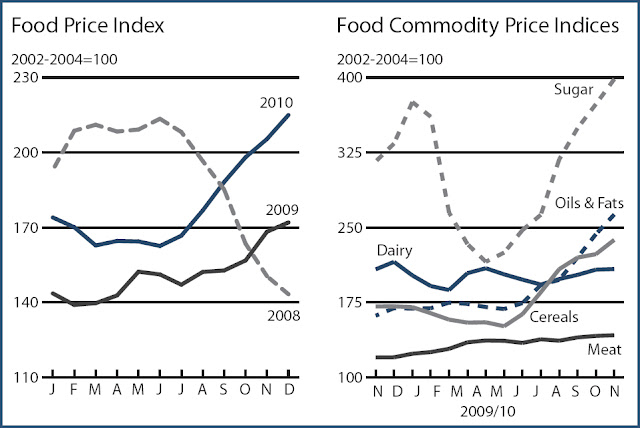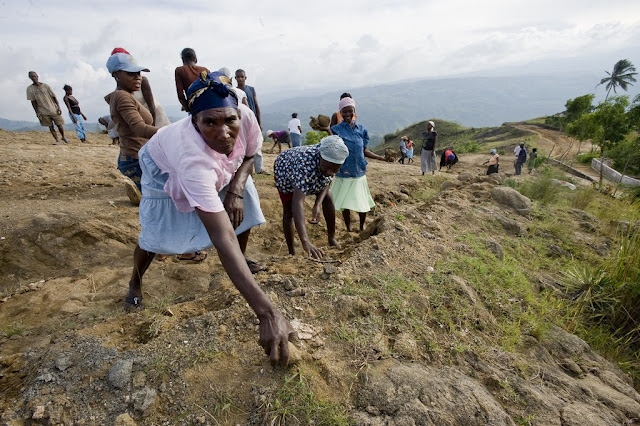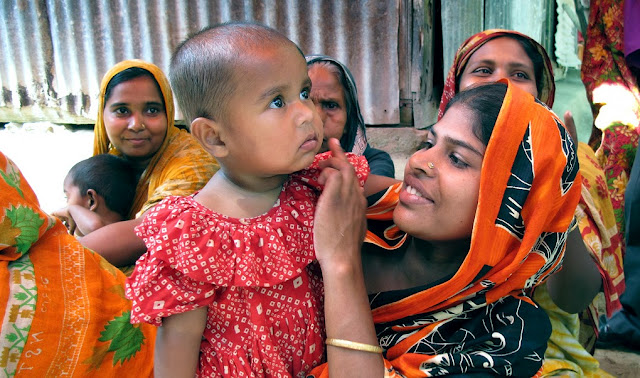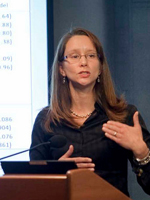Showing posts from category poverty.
-
Edward Carr, University of South Carolina
Why the Poorest Aren’t Necessarily the Most Vulnerable to Food Price Shocks
›February 8, 2011 // By Wilson Center Staff
There have been an interesting series of blog posts going around about the issue of price speculation in food markets, and the impact of that speculation on food security and people’s welfare. Going back through some of these exchanges, it seems to me that a number of folks are arguing past one another.
-
A Lens Into Liberia: Experiences from IRP Gatekeepers
›The International Reporting Project (IRP) gives “editors – the ‘gatekeepers’ – a chance to get out of the newsrooms and to see for themselves the importance of international affairs,” said John Schidlovsky, director of IRP, at a Wilson Center event about the independent journalism organization’s recent two-week trip to Liberia with 11 U.S. news editors. [Video Below]
Schidlovsky stressed the importance of providing international opportunities for journalists in the face of news industry budget cuts. IRP fills the gap by sending gatekeepers, who help determine what news items will be selected for publication or broadcast, to countries that are often underrepresented and neglected in mainstream media.
Three of the gatekeepers, Sunni Khalid, managing news editor at WYPR Baltimore; Ed Robbins, a video journalist; and Teresa Wiltza, senior editor for The Root, shared their observations from their Liberia trip, as well as their insights into the challenges of international reporting.
Economic Challenges and Opportunities
Liberia is slowly beginning to rebuild its economy after a 14-year civil war with more than 200,000 casualties, but there are still “tremendous challenges,” said Khalid. “How do people survive? What kind of jobs do they have? How do they feed their families?”
According to World Bank figures, 84 percent of Liberians earn less than $1 a day, and more than 94 percent earn less than $2 a day. The government’s annual budget is only $369 million, the official unemployment rate is 85 percent, and corruption and lack of infrastructure remain major concerns.
Despite these problems, “Liberia has a lot of good points going for it,” said Khalid. Investment in the country’s raw materials is growing; most recently, the country signed a $7 billion deal with China and a European consortium to continue iron-ore mining.
Initially expecting to “write an obituary for Liberia,” Khalid said he “came out of this trip fairly optimistic about Liberia’s future.” With its “small population, great location, and mineral wealth,” as well as “competent political leadership,” Liberia can take advantage of its potential, he said.
“Capturing the Flavor” of Liberia
Robbins hopes to paint a multidimensional picture of Liberia and “capture the flavor of the country beyond Monrovia,” with his series of short films, which will be available on the websites of both Time and the International Reporting Project,
Robbins previewed one of these films, a profile of the chair of the Liberian Women’s Initiative, Etweda “Sugars” Cooper, who he says “embodies a certain power of a lot of Liberian women in her dedication and also her love for the country.”
At the local level, “the problems of recovery and development are all there in miniature,” said Robbins. But with dedicated leadership from people like Cooper, communities are slowly beginning to rebuild the schools, roads, hospitals, and other infrastructure that was destroyed in the civil wars.
“When you read books and articles, it tends to be really focused on the war and the devastation,” said Robbins. But there is also a sense of optimism among Liberians: “you can see hope in these people, a sense there is something there,” he said.
Empowering Women and Ending Rape
Wiltz pointed out that, “there is a prevailing sense of hope,” particularly among the older generation of women. After years of violence, these female “peace warriors” led the movement that ended Liberia’s civil war. But seven year later, “for women there, the biggest issue is that of economic empowerment,” said Wiltz. “They’re feeling empowered, but they’re broke.”
Sexual violence has become “part of the national psyche,” Wiltz said. During the civil war in Liberia, it has been estimated that more than 60 percent of the female population was raped. Today, “everyone seems sensitized to the issue, and yet it’s still a huge problem,” she said. Sexual violence is still common despite the prevention efforts of radio campaigns, NGOs, and Liberian President Ellen Johnson-Sirleaf.
“You’re in a country where families were destroyed by war,” Wiltz said. In the process of rebuilding Liberia, the new challenge is to engage and empower a new generation of young women and girls. “Underneath the surface there is all this pain and this legacy of extreme cruelty, but they very much want to overcome this.”
Much of the gatekeepers’ coverage is available online: Sunni Khalid produced a week-long series of radio pieces for WYPR, an NPR affiliate; Ed Robbins produced a series of short films for Time; and Teresa Wiltz published several articles on The Root.
Sources: CIA World Factbook, U.S. State Department, World Bank, World Health Organization, WYPR.
Photo Credit: “Liberia Will Rise Again,” courtesy of flickr user Jason Judy. -
National Geographic’s Population Seven Billion
›The short feature above and accompanying cover article in the January 2011 issue launch National Geographic’s seven-part year-long series examining global population. The world is set to hit seven billion this year, according to current UN projections, and may reach nine billion by 2045.
The authors point out that today, 13 percent of people don’t have access to clean water globally and 38 percent lack adequate sanitation. Nearly one billion people have inadequate nutrition. Natural resources are strained. Is reducing population growth the key to addressing these problems?
Not according to Robert Kuznig, author of National Geographic’s lead article, who writes that “fixating on population numbers is not the best way to confront the future…the problem that needs solving is poverty and lack of infrastructure, not overpopulation.”
“The most aggressive population control program imaginable will not save Bangladesh from sea-level rise, Rwanda from another genocide, or all of us from our enormous environmental problems,” writes Kuznig. Speaking on NPR’s Talk of the Nation last week, he reiterated this message, saying global problems “have to be tackled whether we’re eight billion people on Earth, or seven, or nine, and the scale for them is large in any case.”
Instead, the challenge is simultaneously addressing poverty, health, and education while reducing our environmental impact, says Kuznig.
“You don’t have to impose prescriptive policies for population growth, but basically if you can help people develop a nice, comfortable lifestyle and give them the access to medical care and so on, they can do it themselves,” said Richard Harris, a science correspondent for NPR, speaking with Kuznig on Talk of the Nation.
Kuznig’s article highlights the Indian state of Kerala, where thanks to state investments in health and education, 90 percent of women in the state can read (the highest rate in India) and the fertility rate has dropped to 1.7 births per woman. One reason for this is that educated girls have children later and are more open to and aware of contraceptive options.
Whither Family Planning?
In a post on Kuznig’s piece, Andrew Revkin, of The New York Times’ Dot Earth blog, points to The New Security Beat’s recent interview with Joel E. Cohen about the crucial role of education in reducing the impact of population growth. Cohen asks: “Is it too many people or is it too few people? The truth is, both are real problems, and the fortunate thing is that we have enough information to do much better in addressing both of those problems than we are doing – we may not have silver bullets, but we’re not using the knowledge we have.”
Although the National Geographic article and video emphasize the connections between poverty reduction, health, education, and population growth, both give short shrift to family planning. It’s true that fertility is shrinking in many places, and global average fertility will likely reach replacement levels by 2030, but parts of the world – like essentially all of sub-Saharan Africa for example – still have very high rates of fertility (over five) and a high unmet demand for family planning. Globally, it is estimated that 215 million women in developing countries want to avoid pregnancy but are not using effective contraception.
Development should help reduce these levels in time, but without continued funding for reproductive health services and family planning supplies, the declining trends that Kurznig cites, which are based on some potentially problematic assumptions, are unlikely to continue.
As Kuznig told NPR, “you need birth-control methods to be available, and you need the people to have the mindset that allows them to want to use them.”
At ECSP’s “Dialogue on Managing the Planet” session yesterday at the Wilson Center, National Geographic Executive Editor Dennis Dimick urged the audience to “stay tuned – you can’t comprehensively address an issue as global and as huge as this in one article, and within this series later in the year we will talk about [family planning] very specifically.” Needless to say, I look forward to seeing it, as addressing the unmet need for family planning is a crucial part of any comprehensive effort to reduce population growth and improve environmental, social, and health outcomes.
Sources: Center for Global Development, Dot Earth, NPR, Population Reference Bureau, World Bank.
Video Credit: “7 Billion, National Geographic Magazine,” courtesy of National Geographic. -
Andrew Morton, UNEP
Haiti 2011: Looking One Year Back and Twenty Years Forward
›January 14, 2011 // By Wilson Center StaffThis piece first appeared on the website of the Haiti Regeneration Initiative – a new collaborative venture between the UN, the government of Haiti, the Earth Institute at Columbia University, Catholic Relief Services, and a wide range of other implementing partners.
In 2010, Haiti endured a year like no other. The country was struck by a devastating earthquake, a cholera epidemic, floods, violence, and political uncertainty. At the same time, Haiti witnessed heroic rescue and relief efforts and an enormous demonstration of international goodwill. Today, recovery and reconstruction are taking place, albeit at a frustratingly slow pace and not currently at the scale of existing needs.
Just as importantly, 2010 brought a renewed awareness of the need for lasting solutions and improvements in the design and delivery of international aid. During the next few days, we will look back on the tragic events of January 12th, 2010, while at the same time, we must look forward, not just one year, but 20.
A Failed Recovery in a Fragile State
Already before the earthquake, Haiti was a fragile state trapped in a slow but vicious negative spiral. A tightly interconnected trio of chronic environmental, political, and socio-economic crises has gradually ensured that Haiti has had the lowest human development indicators in the Western Hemisphere, with life-long poverty, chronic hunger, and violence. Catastrophic events, such as natural disasters, epidemics, and political violence, have simply steepened the descent. Moreover, disaster recovery efforts to date have systematically failed to bring the country back to pre-disaster levels.
In spite of this depressing analysis and forecast, we should not resign ourselves to failure. The situation can be turned around but only with great effort and by foregoing “business as usual.”
The first step towards change is full recognition of the situation. In the case of Haiti, this means recognizing the marked failure of foreign recovery and development assistance to date. It is pointless to blame any particular institution or individual for this: The current state of Haiti is the culmination of generations of efforts and decisions, good and bad, combined with rapid population growth and an inherent vulnerability to natural hazards. (Editor’s note: according to the UN, Haiti’s fertility rate tripled in the immediate aftermath of the earthquake last year.)
The second step is planning. While relatively solid recovery plans have been developed by the government of Haiti with international assistance, their implementation has not so far met with success, due to four interlinked problems.
First, the humanitarian imperative for urgent and chronic relief is overrunning all good intentions for recovery and development – it is politically impossible, inhumane, and simply unwise to ignore the basic resource needs of a cholera epidemic and a million people living in tents.
Second, nothing suppresses development investments like political violence and uncertainty: Few donors, and even fewer companies, will invest while riots and political uncertainty paralyze the country and destroy its reputation.
Third, the planning process is necessarily democratic and participatory; as a result, however, virtually all of the country’s needs are listed with no reliable process of thematic or geographic prioritization.
Finally – and perhaps most importantly – although the plans are official and uncontested, they generally lack broad credibility and commitment. Weary aid workers, government officials, donors and the general public look back at the fate of previous plans and, not surprisingly, expect these latest efforts to fail just as others have before.
Regenerating Haiti
Unlike virtually all other aid organizations I have met in Haiti, the team behind the Haiti Regeneration Initiative (HRI) has fortunately been given the vital time and seed funding to reflect on these issues and try something really different. After two years of preparation, on January 4, 2010, we launched a long-term rural sustainable development initiative for the southwestern tip of Haiti. The Côte Sud Initiative aims to transform the lives and the degraded environment of 200,000 people living in one of the poorest yet most beautiful parts of Haiti.
This specific initiative will only directly assist two percent of the population of Haiti, but just as importantly, we aim to demonstrate that sustainable development is truly possible in this country. Because national-scale issues require national-scale efforts, we also aim to promote change through dialogue and assisting the government of Haiti to develop and deliver on sustainable development plans that work. This is the primary mission of the HRI.
We must arrest the long-term decline as soon as possible. This includes, but is not limited to, basic recovery from the earthquake. At the same time, we need to establish the foundations for the long-term radical changes that are an absolute prerequisite to achieving sustainable development in Haiti. We must prepare to turn the vicious circles into virtuous ones.
So what are the short- to medium-term priorities?
The first is political stabilization, as vital foreign aid and direct foreign investment will simply not arrive in the face of such negative news and uncertainty.
Second, a massive aid investment in potable water and sanitation is required to suppress cholera in the longer term. No country can develop in the midst of recurrent major epidemics. This investment needs to be designed for sustainability; in other words, infrastructure needs to be accompanied by realistic, locally financed mechanisms for maintenance. Otherwise it will become useless within weeks of installation.
Third, persistence is needed on the current debris clearance and rebuilding efforts; we know from many other countries that such efforts can take years to be completed.
Finally, development aid should move out of Port-au-Prince and into the regions. In 2010, the massive influx of earthquake relief and reconstruction aid actually increased the economic pull of the capital and exacerbated existing urban problems.
What to do to prepare for the long term? Implementing radical change requires political support and even cultural reform, so in addition to good ideas, the HRI partnership will work hard to develop a sense of national ownership of the solutions as well as the problems.
Many of the ideas are not new: mildly decentralized development, diversified and value-added agriculture, niche tourism, improved aid coordination, public-private partnerships, etc.
Many, however, are radical, including a proposed paradigm change on migration and remittances, education, food security and import policies, widespread privatization, harsh revisions and rebuttals of traditional development models and assumptions, and adaptation to the new types of religious NGOs. These are just a few of the concepts and opportunities we have identified and will work to make a reality in Haiti.
Over the next few years, the HRI hopes to foster an intelligent and useful dialogue on sustainable development in Haiti. We look forward to having all of those who are concerned about and interested in helping Haiti join us in the debate.
Andrew Morton is the Haiti Regeneration coordinator and a senior staff member at UNEP. For more information on the Haiti Regeneration Initiative please see www.haitiregeneration.org.
Sources: BBC, Haiti Regeneration Initiative, United Nations Development Programme.
Image Credit: “Rebuilding as a community,” courtesy of flickr user Save the Children. -
Watch: Annie Wallace on Connecting PHE Approaches With Climate and Poverty
›“It’s really important to link the integrated PHE approach with the policies and strategies of the country,” says Annie Wallace, who worked as a PHE technical advisor with USAID’s Global Health Fellows Program in Ethiopia. “Because if you don’t have political buy-in from the decision-makers and the leaders, then it’s going to be really difficult to justify the allocation of different funds for these projects to be expanded to other regions, or expanded in scale, or even to expand outside of the country.”
With Ethiopia in particular, Wallace stressed the importance of PHE practitioners connecting their integrated approach with how it will help address the country’s poverty alleviation and climate change adaptation strategies. “The prime minister is a leader in Africa talking about climate change,” Wallace said, “and we really need to talk about how an integrated approach can help with adaptation and reducing a community’s vulnerability to climate change.”
On the funders’ side, Wallace noted that as monitoring and evaluation becomes more important, donors also need to be able to support building capacity in organizations in order to meet the new requirements. During her work with The David and Lucile Packard Foundation (via USAID), Wallace helped set up the PHE Ethiopia Consortium to facilitate such capacity-building efforts. -
New Insights Into the Population Growth Factor in Development
›“We have not found any country that has developed or gotten out of poverty while maintaining high birth rates,” said Martha Campbell, president of Venture Strategies for Health and Development. “Family planning is not a cost to a Ministry of Finance – it’s an investment,” said Malcolm Potts of the University of California Berkeley.
Campbell and Potts were joined by panelists Eliya Msiyaphazi Zulu, director and founder of the African Institute for Development Policy, and Jotham Musinguzi, director of the African Region at Partners in Population and Development, for a Wilson Center discussion of the implications of rapid population growth on human and economic development. [Video Below]
Africa’s Key Population Growth Challenges
“Africa’s population of one billion can reach between 1.8 and 2.3 billion by 2050, depending on how well the continent actually does in reducing fertility,” Zulu said. In 2010, Africa accounted for 15 percent of the total world population, but current estimates suggest this will grow to 23 percent by 2050.
“Rapid growth, young age structures, and urbanization are Africa’s main population challenges,” said Zulu. “Addressing these concerns is increasingly seen to be the key to the continent’s development prospects and realization of the Millennium Development Goals.” With 40 to 50 percent of populations in Africa under the age of 15, there is “high momentum for further population growth,” he said.
“Africa has a very high demand for fertility control, and the demand will undoubtedly increase,” said Zulu. “The main challenge, therefore, is not that of demand, but how to ensure those who are in need actually have access to contraception.” In many African regions, current rates of contraception use are as low as seven percent. In some areas, as many as 97 percent of women cannot afford the full cost of contraception, he said.
“It’s not just about reducing fertility,” said Zulu. Improving education and increasing labor force opportunities will not only help populations develop economically, but will also allow African countries to take full advantage of the demographic dividend, he said.
“The international development community should build on Africa’s success stories and support efforts to achieve universal access to family planning, expand public education on reproductive matters, improve the status of women, and improve the situation in urban settings,” Zulu concluded.
Family Planning and the MDGs
“Women are dying; children are dying. They shouldn’t be,” said Musinguzi. “By investing US$1 million in family planning, you can prevent 800 maternal deaths, 11,000 infant deaths, 14,000 deaths in children under five, and 360,000 unwanted pregnancies.”
“Women are clearly saying they have a need for family planning,” Musinguzi said. Presenting statistics from sub-Saharan Africa, he noted that 31 countries have a total fertility rate of more than five. Fourteen million unintended pregnancies occur each year, but only 25 percent of women use family planning. In Uganda, for example, the population has more than doubled in less than 20 years; women on average have more than six children each; and only 18 percent of married women use modern contraception.
“For a country trying to achieve the MDGs…the question of addressing total fertility rate is very important,” said Musinguzi. Reducing unmet need for family planning services can help African countries reduce the costs of achieving several of the Millennium Development Goals, including offering universal primary education; reducing child mortality; improving maternal health; combating HIV/AIDS, malaria, and other diseases; and ensuring environmental sustainability.
Policy Implications
“This is an urgent message – waiting 10 years to get family planning back on the international agenda will be enormously costly,” Potts said. “Of all the medical interventions that exist, contraception is the single most powerful. It is the only one that can have an impact on maternal and infant mortality, on the autonomy of women, on economic progress, on social stability and the rate at which we destroy the environment,” he said.
“Education and family planning are the driving mechanisms of development – they’re synergistic,” said Potts. “One of our needs is to get economists, family planning, and development experts on the same page.”
Sources: Guttmacher Institute, Population Action International, Population Reference Bureau.
Photo Credit: Untitled, courtesy of flickr user stttijn. -
Evidence, Links, and Solutions
Maternal Undernutrition
›“Maternal undernutrition is often overlooked as a strategy for reducing poverty and as a key intervention to reduce maternal mortality and morbidity,” said Mary Ellen Stanton, senior maternal health advisor at the U.S. Agency for International Development. Stanton was joined by Dr. Doyin Oluwole, director of the Africa’s Health in 2010 program, and Amy Webb Girard, assistant professor at the Emory University School of Public Health, in the final meeting of the Advancing Policy Dialogue on Maternal Health series on December 15 where they addressed the linkages between poverty, undernutrition, and poor maternal health outcomes.
The Cycle of Malnutrition and Poverty
Many factors contribute to a woman’s nutritional status, including lack of capital, access to land, and poverty; thus, said Oluwole, “we must adopt a multi-pronged and multi-sectoral response.”
“General malnutrition is usually associated with iron-deficiency anemia, which leads to poor cognitive function and educational achievement, poor health, and fatigue.” Oluwole said. “These three factors lead to low worker productivity, and low worker productivity leads to income poverty.”
“All of these aggravate malnutrition and so the vicious cycle of malnutrition and poverty continues,” said Oluwole. To break this cycle, she pointed out that countries like Malawi and Mexico have implemented various multi-sectoral interventions that have “stimulated economic growth; implemented targeted social, health, and nutrition programs; and put in place safety nets.”
“In the window of opportunity during pregnancy and the first two years of life, we can make a big difference,” Oluwole said. She advocated for an “integrated anemia package” that provides anti-malarials, de-worming medicine, iron folic acid tablets, and extra food during pregnancy. She also noted the importance of family planning and targeted high-coverage interventions, such as salt iodization, vitamin A supplementation, and breastfeeding promotion.
In conclusion, Oluwole provided several recommendations for the development community to improve maternal mortality rates and undernutrition of women:
Maternal Undernutrition: Our Global Disgrace- Promote universal primary and secondary education, especially for girls
- Stimulate economic growth with a focus on gender and equity
- Invest in infrastructure to reduce transportation time to hospitals
- Postpone age of marriage and of first pregnancy
- Provide targeted and effective nutrition and health interventions
- Encourage private sector participation and government leadership
- Integrate the maternal health and nutrition communities and services
“We don’t tend to look at maternal nutrition and its impacts on the woman herself,” said Girard. The lack of data on the relationship between nutrition and maternal health outcomes “hampers our ability to move maternal nutrition onto the health and development agenda,” she added.
“Anemia is widespread; worldwide, it is a significant public health burden, both in women of reproductive age as well as in pregnant women,” said Girard. Studies have shown that moderate anemia increases risk of hemorrhage and may also increase the risk of sepsis, while severe anemia has been shown to directly contribute to maternal mortality. Targeted interventions can help reduce these risks greatly. “For every one gram per deciliter increase in hemoglobin level, you can reduce maternal mortality by approximately 25 percent, but the mechanisms by which this occurs are not well elucidated,” noted Girard.
“We need to include women not as just targets of nutritional interventions, but as beneficiaries in their own health,” said Girard. Key nutritional interventions such as micronutrient supplementation, fortification, and behavior change communication can help to improve not only fetal, infant, and child health, but can also reduce maternal morbidity and mortality. In addition, Girard recommended the following strategies to achieve greater impact:
Together, these strategies can help improve access to nutrition and health services, as well as adequate food for women throughout their lives. “We need to integrate health and nutrition – they are actually the same pillar, complementing each other,” Girard concluded.- Improve nutrition throughout the life cycle, not just during pregnancy
- Look for alternate strategies for micronutrient delivery
- Integrate maternal nutrition into food security and agricultural strategies
- Collect indicators specific to women’s health impacts
- Recognize and address gender bias
Photo Credit: “Bangladesh mothers, kids,” courtesy of flickr user Bread for the World. -
The World’s Toilet Crisis
›Forty percent of the world’s population – 2.6 billion people – do not have access to toilets, and some in the international aid community are finally dispensing with the euphemisms and calling this sanitation crisis what it is: “shit.”
In “The World’s Toilet Crisis” (trailer above), Adam Yamaguchi sets off in an episode of Current TV’s Vanguard program to tell the story of “the deadliest killer in the world…something no one wants to talk about.” All around the developing world, thanks in part to rapid population growth and poor development and environmental standards, “people are literally eating their own shit,” he said.
His journey takes him to India, where more people own cell phones, than toilets. The 55 percent of Indians who practice open defecation have contributed to another grim statistic: an estimated 840,000 children under the age of five die in India each year from diarrheal diseases.
India’s water quality is especially affected by lack of sanitation. In the documentary, Yamaguchi visits the Yamuna River, which is Delhi’s primary source of drinking water, and has become a “giant toilet” literally bubbling with methane gas. This phenomenon is not unique to India. Approximately 80 percent of sewage in developing countries goes untreated, polluting local water resources.
But it is women who feel the effects of lack of access to clean water and toilets most keenly. In 72 percent of households around the world, women are the primary water collectors, often travelling long distances for drinkable water. They face shame and harassment when going to the bathroom, causing them to suppress their need until dark, causing negative health effects. Waiting until nightfall also means that when women openly defecate, they often face molestation, violence, and rape. Teenage girls also often drop out of school once they begin to menstruate because toilets are not private, unsafe, or are simply nonexistent.
Reflecting on his motivations for making the documentary, Yamaguchi said that in order to expose this “global public health crisis,” he needed to be as graphic, shocking, and disgusting as possible.If you’re not grossed out by, or incensed by the fact that there is shit everywhere, you’re not really moved to act or change your ways. And that’s ultimately what’s happened in many places in the world. It’s a normal fact of life. You see it everywhere, and you think nothing of it. There are causes out there that are deep sexy causes or marketable causes. Shit or toilets – not the most marketable thing in the world.
“The World’s Toilet Crisis” forms part of a broader trend among sanitation advocates to use crude language to address a problem the international health and development community has traditionally shied away from talking about directly.
Tales of shit: Community-Led Total Sanitation in Africa, published shortly before World Toilet Day by the International Institute for Environment and Development, takes an equally direct approach to sanitation.
Community-Led Total Sanitation (CLTS) is an approach begun with great success by Dr. Kamal Kar in Bangladesh that relies on “triggering” to change community behavior. The report, which is prefaced by a three-page “International Glossary of Shit” listing the words for shit in other languages, emphasizes the need to “explicitly [talk] about and [make] visible the shit that is normally hidden beneath taboos and polite language.” By almost literally thrusting people’s shit right under their noses, communities learn what they have been ignoring: that they are “eating each others’ shit.”
Traditional sanitation programs often fail because “a high proportion of latrines constructed with subsidies are never used as toilets, but as storage space, animal shelters, or prayer rooms – the buildings are too high quality to be wasted on toilets!” says the report. CLTS, on the other hand, focuses on changing behavior at the community, rather than the individual level to create sustainable change that responds and adapts to a community’s distinct culture and needs.
“The World’s Toilet Crisis” shows the promise CLTS has of meeting the needs of the billions without toilets. In East Java, Yamaguchi joins a community leader to collect a “specimen” from a well-traveled river bank near the town, which he proceeds to show to a group of women in the town who are, predictably, revolted. The community then takes collective action to become “open-defecation free” and invest in toilets.
“The World’s Toilet Crisis” is not easy to watch, nor was it easy to film – seven minutes in, Yamaguchi vomits on the banks of the polluted Yamuna River. Disgust, however, is central to raising awareness and affecting change on both the community and global levels. As Yamaguchi explains, “You’re going to get grossed out by seeing this piece, and that’s part of the point.”
Sources: Community-Led Total Sanitation, Current TV, Earth Times, IIED, Water.org, World Toilet Organization, WHO, United Nations University.
Video Credit: “The World’s Toilet Crisis – Vanguard Trailer,” courtesy of Current TV’s Vanguard.










